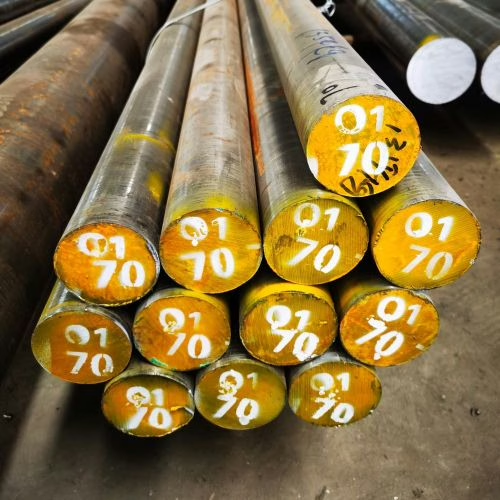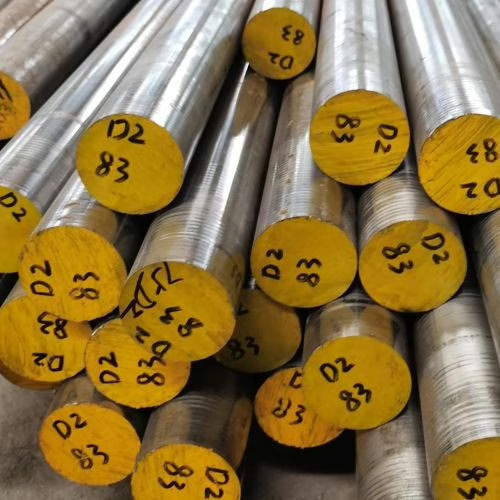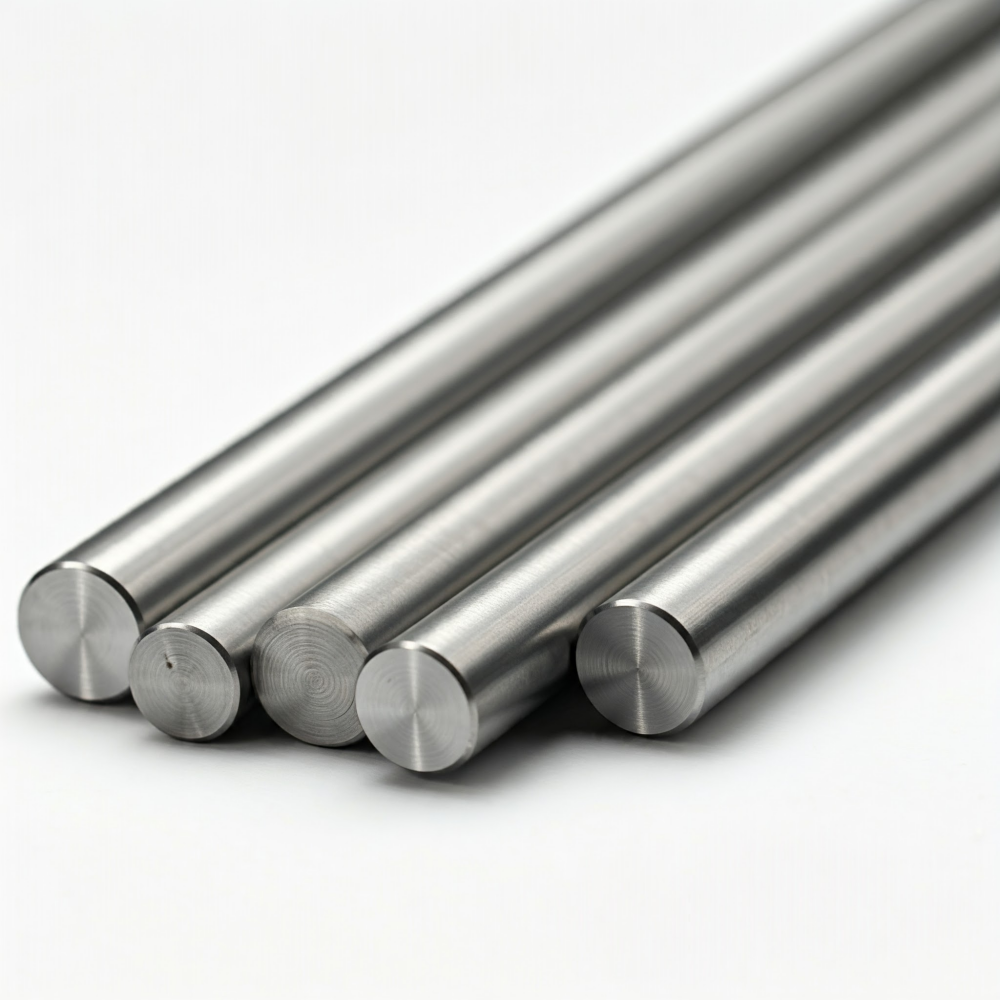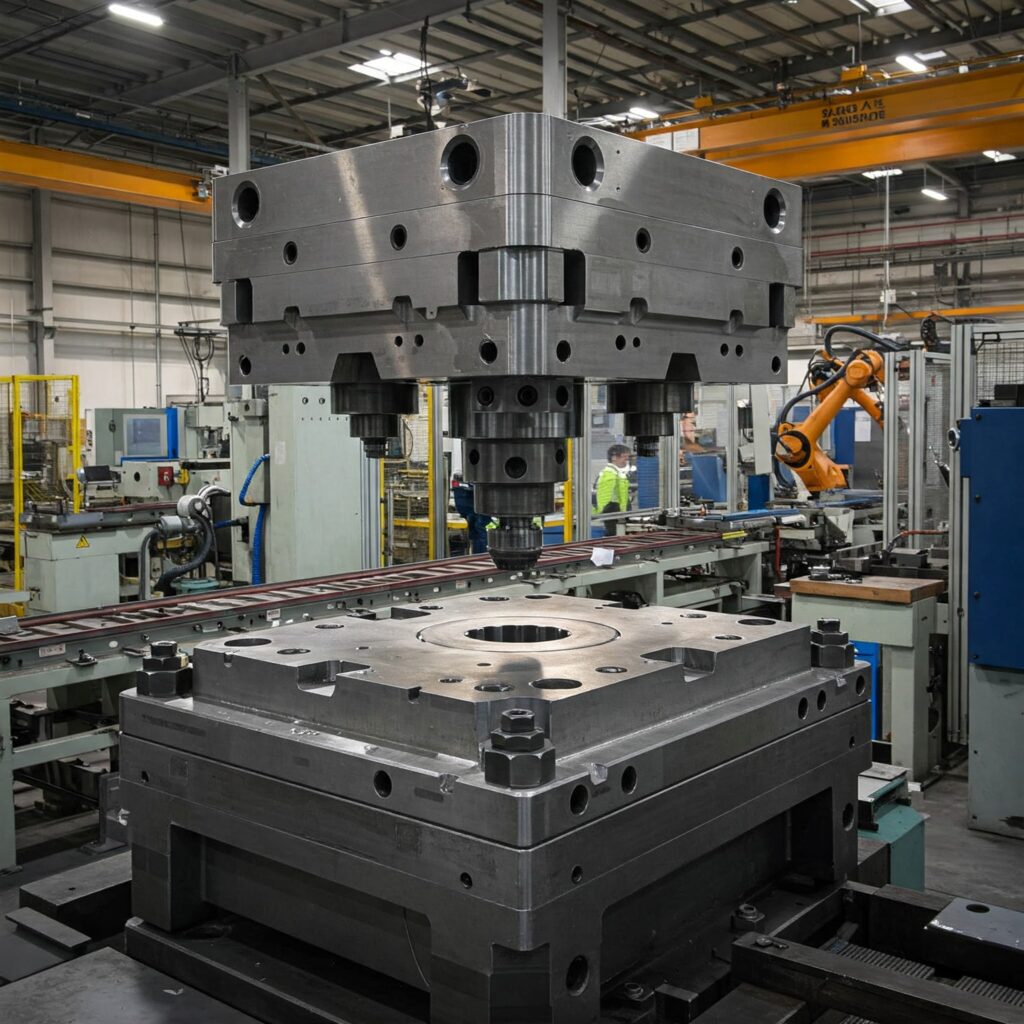الوقت المقدر للقراءة: 7 دقائق
النقاط الرئيسية
- يعد الفولاذ المستخدم في الأدوات O1 وD2 كلاهما من الفولاذ المستخدم في الأدوات التي يتم العمل عليها على البارد، ولكنهما يتمتعان بتركيبات كيميائية وتطبيقات مميزة.
- يتمتع O1 بقدرة تصنيع أفضل ومتانة أعلى، بينما يوفر D2 مقاومة فائقة للتآكل واستقرارًا أبعاديًا.
- من حيث المعالجة الحرارية، فإن O1 يتصلب بالزيت وعرضة للتشقق، في حين أن D2 يتصلب بالهواء مع الحد الأدنى من مخاطر التشوه.
- تتضمن تطبيقات O1 أدوات للأغراض العامة، بينما يفضل استخدام D2 للأدوات عالية التآكل التي تتطلب استخدامًا لفترات طويلة.
- يعتمد الاختيار بين فولاذ الأداة O1 مقابل D2 على ما إذا كنت تعطي الأولوية لسهولة التصنيع أو زيادة عمر التآكل.
جدول المحتويات
فولاذ الأدوات O1 مقابل D2: فولاذ الأدوات O1 و فولاذ الأدوات D2 كلاهما من فولاذ الأدوات المُستخدم على نطاق واسع في العمل البارد، لكنهما يتميزان بخصائص مميزة تجعلهما مناسبين لتطبيقات مختلفة. تُبرز المقارنة التفصيلية نقاط قوتهما ونقاط ضعفهما.


فولاذ الأدوات O1 مقابل D2: التركيب الكيميائي
| العنصر | فولاذ الأدوات O1 (%) | تركيبة الفولاذ D2 (%) |
| الكربون (C) | 0.85 – 1.00 | 1.40 – 1.60 |
| الكروم (Cr) | 0.40 – 0.60 | 11.00 – 13.00 |
| المنجنيز (Mn) | 1.00 – 1.40 | 0.10 – 0.60 |
| الفاناديوم (V) | 0.15 – 0.30 | 0.50 – 1.10 |
| الموليبدينوم (Mo) | – | 0.70 – 1.20 |
| التنجستن (W) | 0.40 – 0.60 | – |
| السيليكون (Si) | 0.10 – 0.50 | 0.10 – 0.60 |
| الفوسفور (P) | ≤ 0.03 | ≤ 0.03 |
| الكبريت (S) | ≤ 0.03 | ≤ 0.03 |
فولاذ الأدوات O1 مقابل D2: الخصائص الميكانيكية
- صلابة. يتمتع فولاذ O1 وفولاذ D2 بصلابة عمل متشابهة. صلابة الفولاذ O1 58–60 HRC. صلابة الفولاذ D2 تتراوح كثافتها بين 58 و61 HRC، ويمكن أن تصل إلى 60 و62 HRC بالمعالجة الحرارية، وحتى 63 و64 HRC عند إنتاجها باستخدام معالجة مسحوق المعادن (P/M). صلابة روكويل للفولاذ O1 أقل قليلاً من D2.
- قوة. يتمتع O1 بمقاومة خضوع تبلغ 829 ميجا باسكال (758 ميجا باسكال UTS). وكانت مقاومة خضوعه للضغط أعلى من مقاومة فولاذ D2. تبلغ مقاومة خضوع D2 411 ميجا باسكال (350 ميجا باسكال UTS)، وقوة الشد 758 ميجا باسكال.
- الصلابةبالمقارنة مع O1، يتمتع فولاذ D2 بمتانة أقل. وتُقلل الكمية الكبيرة من الكربيدات في فولاذ D2 من متانته.
- اللدونة/اللدونةيتميز فولاذ O1 بليونة أعلى من فولاذ D2. يُظهر O1 انكماشًا ملحوظًا قبل الكسر، مع انخفاض محسوب في المساحة يُقدر بحوالي 19.7%. أما D2، فلم يُظهر أي انكماش تقريبًا قبل الكسر، مع انخفاض في المساحة يُقدر بحوالي 1.3%.
- مقاومة التآكل/مقاومة التآكل. يتميز فولاذ D2 بمقاومة تآكل أفضل مقارنةً بفولاذ O1. يتميز فولاذ O1 بمقاومة تآكل متوسطة، بينما يتميز فولاذ D2 بمقاومة تآكل عالية جدًا. ويرجع ذلك إلى أن نسبة الكربون والكروم العالية في فولاذ D2 تُنتج كمية كبيرة من كربيدات M7C3 الغنية بالكروم.
- الاستقرار/التشويه البعديمقارنةً بأنواع فولاذ الأدوات الأخرى، يتمتع فولاذ D2 بأفضل ثبات أبعادي أثناء المعالجة الحرارية، مع أن فولاذ O1 يُظهر أيضًا تغيرات أبعادية طفيفة أثناء التبريد بالزيت. يُصلب فولاذ D2 بشكل أساسي بالهواء، مع تمدد أو انكماش يبلغ حوالي 0.0005 بوصة لكل بوصة.
- قابلية التصنيع/الطحنيتميز فولاذ O1 بسهولة تشغيل ممتازة، حيث يبلغ تصنيفه 90 مقارنةً بـ 100 لفولاذ الكربون 1%. أما فولاذ D2، فهو ضعيف بشكل خاص من حيث سهولة التشغيل، حيث يبلغ تصنيفه 45 مقارنةً بـ 100 لفولاذ الكربون 1%. ومن الواضح أن فولاذ O1 يتميز بسهولة تشغيل أفضل بكثير.
مقارنة المعالجة الحرارية
O1 هو فولاذ مُقَسّى بالزيت، يُعرف أيضًا بالفولاذ المُخَفَّى بالزيت، يُغَمَّر بسرعة في الزيت للتبريد بعد تسخينه إلى درجة حرارة الأوستنيت. تُعرِّض عملية التبريد السريع بالزيت الفولاذ لصدمة حرارية كبيرة. وبالتالي، يُشكِّل O1 مخاطر سلامة متوسطة أثناء عملية التبريد، إذ يكون عُرضةً للتشقق نتيجةً للصدمة الحرارية وتغيرات أبعادية كبيرة نسبيًا أو مخاطر تشوه. بالمقارنة مع الفولاذ المُقَسّى بالهواء، يُظهِر O1 ثباتًا أبعاديًا أقل. يُقدَّر التمدد أثناء التبريد بحوالي 0.0015 مم/مم. بالإضافة إلى ذلك، يكون O1 عُرضةً لإزالة الكربون أثناء المعالجة الحرارية، حيث يفقد محتوى الكربون السطحي، مما يُؤدي إلى صلابة سطحية غير كافية.
D2 هو فولاذ مُقَوّى بالرياح، يُعرف أيضًا بالفولاذ المُقَوّى بالهواء. عند تبريده من درجة حرارة الأوستنيت، يصل إلى صلابته الكاملة ببساطة عن طريق التبريد الطبيعي في الهواء الساكن. ولأن D2 يحتوي على نسبة عالية من عناصر السبائك، فإن هذه العناصر تُبطئ بشكل ملحوظ معدل التحول الهيكلي الدقيق داخل الفولاذ. التبريد بالهواء عملية تبريد بطيئة ولطيفة للغاية. وبالتالي، يتميز D2 بأمان عالٍ للغاية أثناء التصلب ومقاومته الشديدة للتشقق. أثناء المعالجة الحرارية، يُظهر D2 تشوهًا ضئيلًا، مع معدل تمدد أو انكماش منخفض جدًا يبلغ حوالي 0.0005 مم/مم. بفضل ثباته البُعدي المتميز، يُعد D2 المادة المُفضلة لتصنيع القوالب الدقيقة ذات الأشكال الهندسية المعقدة والتفاوتات الدقيقة للغاية.
| ميزة | المعالجة الحرارية للصلب O1 | معالجة حرارية للفولاذ D2 |
| درجة حرارة التصلب/الأوستنيت | 802–816 درجة مئوية (1475–1500 درجة فهرنهايت) | 1010–1024 درجة مئوية (1850–1875 درجة فهرنهايت) |
| وسط الإطفاء | تصلّب بالزيت. تصل إلى الصلابة الكاملة عند إخمادها بالزيت. | التصلب الهوائي أساسًا. قد يلزم تبريد الأجزاء الثقيلة بالزيت. |
| التقسية | يتم تدفئتها عادة عند درجة حرارة 149–232 درجة مئوية (300–450 درجة فهرنهايت). | يتم معالجتها في درجات حرارة منخفضة، حوالي 200 درجة مئوية (392 درجة فهرنهايت)، لتحقيق صلابة عالية. |
| إزالة الكربون والتكسير | يعاني من إزالة الكربون أثناء المعالجة الحرارية ويتعرض للتشقق بسبب الصدمة الحرارية أثناء إخماد الزيت. | يتميز D2 بمقاومة عالية للتشقق أثناء تشكيل وتصنيع المعادن. |
السلوك الميكانيكي وخصائص الكسر
أظهرت دراسة تبحث في اللدونة وسلوك الكسر المطاوع لفولاذ الأدوات الباردة O1 وD2 المصنع محليًا تحت اختبارات الشد والضغط شبه الثابتة الرتيبة اختلافات ميكانيكية كبيرة.
| ملكية | فولاذ الأدوات O1 | فولاذ الأدوات D2 |
| قوة الخضوع للشد | أعلى (829 ميجا باسكال) | أقل (411 ميجا باسكال) |
| قوة الخضوع للضغط | أعلى | أدنى |
| سلوك العنق | ظهور ترقق واضح قبل الكسر | لا يوجد تقريبًا أي انحناء قبل الكسر |
| تقليل المساحة عند الكسر | مرتفع (19.7%) | منخفض (1.3%) |
| وضع الكسر | وضع كسر الكأس والمخروط | وضع الكسر السطحي المسطح |
في هذه الدراسة المحددة،, أظهر O1 قوة خضوع شد أعلى وقوة شد قصوى بالمقارنة مع D2. وعلى العكس من ذلك، أظهر O1 خصائص تليين معدني عالي خارج UTS، وهو ما يتضح من خلال التعنق الواضح وانخفاض كبير في المساحة عند الكسر (19.7%)، مما أدى إلى سطح كسر مخروطي الشكل.
أظهر D2، على الرغم من امتلاكه ليونة وصلابة أعلى قليلاً مما لوحظ في سياق عناصر السبائك (Mo، V، Cr)، عدم وجود أي تعنق تقريبًا وانخفاض أقل بكثير في المساحة (1.3%)، مما يؤدي إلى وضع كسر السطح المسطح.
التطبيقات وقابلية التصنيع
يعتمد الاختيار بين O1 وD2 على إعطاء الأولوية إما للتصنيع المبسط أو عمر الخدمة الطويل في التطبيقات الصعبة.
تشير قابلية التشغيل إلى مدى سهولة قطع الفولاذ أو تشكيله في حالته الملدنة. تتناسب هذه الخاصية بشكل أساسي عكسياً مع محتوى الكربيد الداخلي. يتمتع O1 بقابلية تشغيل ممتازة. يتلقى تصنيف قابلية تشغيل عالية يبلغ 90، مع وجود فولاذ الكربون 1% كمعيار 100. إن محتواه المنخفض من السبائك، وخاصة الغياب شبه الكامل للكربيدات الصلبة داخل هيكله، يجعل القطع سهلاً للغاية. ومع ذلك، فإن D2 يصعب تشغيله وطحنه للغاية. نظرًا لمحتواه العالي للغاية من الكربون والكروم، فإن الفولاذ مملوء بكميات كبيرة من الكربيدات الكاشطة عالية الصلابة، مثل الحصى في ورق الصنفرة. ينتج عن هذا تصنيف قابلية تشغيل منخفض للغاية يبلغ 45. حتى أن طبيعة D2 "الصعبة التعامل معها" اكتسبت لقب "الكلب" بين بعض صانعي الأدوات، مما يعني أنه مزعج بشكل خاص.
- تطبيقات O1: يُستخدم O1، باعتباره "فولاذًا قديمًا متعدد الاستخدامات"، على نطاق واسع في الأدوات والقوالب الصغيرة، خاصةً حيثما يتطلب الأمر قابلية تشغيل جيدة وتوازنًا ممتازًا بين المتانة والصلابة. تشمل التطبيقات الشائعة قوالب القطع، وقوالب سكّ المعادن، وقوالب التشكيل، والمقاييس، وبعض أجزاء الآلات (مثل البطانات، والكامات، والأدلة).
- تطبيقات D2: يُعدّ D2 المعيار الصناعي لتطبيقات تشكيل الأدوات الباردة التي تتطلب تشغيلات طويلة ومقاومة عالية للتآكل. ويُفضّل بشكل خاص لعمليات التصنيع طويلة الأمد، حيث تُقلّل مقاومته العالية للتآكل وثبات أبعاده من وقت التوقف عن العمل. تشمل التطبيقات قواطع الثقب والقوالب، وقوالب القطع طويلة المدى (التي تُستخدم غالبًا للإنتاج الضخم للصلب والمعادن الأخرى)، وقوالب لف الخيوط.
إجراء الاختيار
يُمثل D2 ثباتًا أبعاديًا فائقًا ومقاومة فائقة للتآكل. من ناحية أخرى، يوفر O1 متانة أكبر وسهولة في التشغيل.
عندما يُولي تطبيقك الأولوية لزيادة عمر التآكل وتقليل تشوهات المعالجة الحرارية، فإن D2 هو الخيار الأمثل. يُشكل محتواه العالي من الكربون والكروم كربيدات فائقة المتانة، مما يجعله المادة المثالية لقوالب التشغيل المستمر طويلة الأمد وعالية الحجم. على الرغم من صعوبة تشغيله ومتانته المنخفضة، إلا أن ثباته البُعدي ومقاومته الممتازة للتآكل لا يُضاهيان O1.
يُعدّ O1 الخيار الأمثل للأغراض العامة. عندما تُولي التطبيقات الأولوية لقابلية التشغيل الممتازة، والتكلفة المنخفضة، والمتانة العالية، يُعدّ O1 الخيار الأمثل. فهو مُناسب بشكل أفضل لتصنيع الأدوات أو القطع الصغيرة والمتوسطة الحجم التي تتطلب توازنًا مثاليًا بين الصلابة والمتانة، مع سهولة التشغيل في الوقت نفسه. على الرغم من أن عمره الافتراضي ليس طويلًا مثل D2، وأن هناك خطرًا مُعينًا للتشوه (الاعوجاج) والتشقق أثناء التبريد بالزيت، إلا أن توازنه العام ممتاز.


